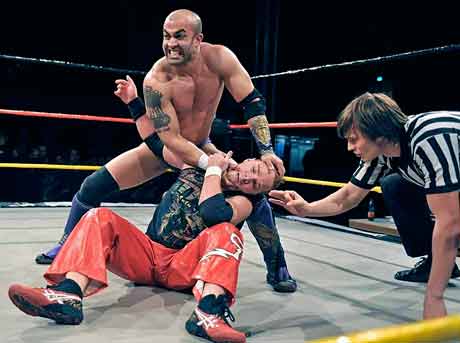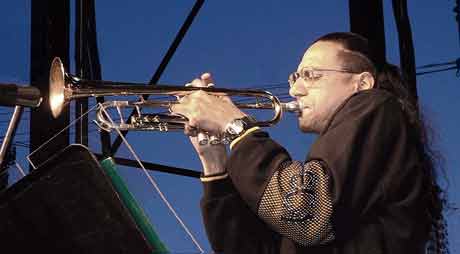Pioneers

By Rishma Lucknauth
All the world’s a stage and all the men and women in the ring merely wrestlers. When it comes to pro-wrestling it’s no holds barred and it’s all in good entertainment.
It was the form of entertainment in the late 80s to mid 90s, until a vast decline from its golden age heyday in the early 2000s. Today wrestling seems more like a back-alley whisper than the crowd-roaring event it used to be. But like the men and women roped in the ring, pro wrestling is struggling to keep a firm grip on its salad days and transition back into the limelight of mainstream culture.
“It was the hottest thing going on at the time,” said Sonjay Dutt, independent pro wrestler and former TNA eventer. “A couple years after that, the popularity kind of died down. I guess it's kind of still like that now.”
Dutt, 28, started wrestling at the turn of the century, spending over six years contracted by Total Nonstop Action (TNA) which guaranteed him televised matches and a place under the spotlight—including a video game version of himself in TNA Impact! released for Playstation, Xbox and Wii. The American based wrestler—also known as the Original Playa from the Himalaya—has been freelancing ever since, and most recently headlined a Toronto event with a few local wrestlers at the Hangar in Downsview Park.
The event took place in a ring erected in a gutted workshop that once housed aircrafts in need of repair. Bleacher-style seating provided wide-eyed children in luchador masks a vantage point from which to anxiously await the entrance of their superhero wrestler. Apart from the scanty audience of around 100, it wasn’t very different from what a match would have appeared like 20 years ago.
At its height, pro wrestling produced many long-remembered performers, many of whom would be perfect contenders for a where-are-they-now television special. There's reality TV star Hulk Hogan, former Minnesota governor Jesse “The Body” Ventura, popular actor Dwayne “The Rock” Johnson and actor “Stone Cold” Steve Austin. Their gimmicks become the sort of typecast that either hurt or hinder their future careers. But for guys like these, they've been able to use their fame to build a career outside the ring, only to later shed their wrestling image.
It's sometimes difficult to tell where the persona ends and the sports-entertainer begins. The fourth wall tumbled many years ago when spectators learned the trade secrets of pro wrestling—the outcome is rigged and the fighters were actually gimmicks. But that hasn’t put much of a damper on it—at least not prior to the early 2000s which many consider the time that pro wrestling exited mainstream culture.
Despite its mainstream exodus, there is still a huge culture of wrestling worldwide, the largest of which is based in the United States under the arms of World Wrestling Entertainment, Inc.(formerly known as the World Wrestling Federation)—a multi-million dollar sport-entertainment company which has been billing some of the biggest names in the game since it was founded in 1952. WWE's presence helped spawn other companies including TNA, which engaged younger wrestlers and reached their target audience of 18 to 25 year-olds—a group that pro wrestling had fallen out of favour with.
According to Rob Fuego, former pro wrestler and head trainer at Squared Circle Training, wrestling died down towards the 90s when the younger audience which it drew in the 80s started to grow up and shy away from the PG-rated performances. “It [started to cater to] the older crowd,” said Fuego. “It became a little more sexy and little more violent. Now they're going back to the PG rating to get the kids back in.”
“I don't think it'll ever get as big as it was. Unless someone comes around that's a huge star that appeals to everybody.”
Fuego believes the onset of internet which moved audiences from the television to their computers, and the popularity of reality TV that has shed light on the unreality of it all, can be partly to blame for the dissipation of wrestling.
What may have brought new attention to wrestling, and somewhat of a temporary resurgence in popularity, is The Wrestler, an Oscar-nominated film starring Mickey Rourke, which depicts the way the cookie crumbles for many wrestlers who have been in the game for most of their lives.
“[It's] realistic for a lot of the old timers that wrestled for many years,” Dutt said. “Once they get that last pennant they don't know where to go from there, there is no other avenue for them to make a living. After wrestling for so many years it's hard to transition to a nine to five.”
The film brought attention to the harsh realities of wrestling: it takes a tremendous toll on their physical health, doesn't exactly offer job security and when injuries happen, can leave a wrestler unskilled and unadjusted to real life. “It's a tough life,” added Dutt. “Wrestling can either be really good to you or really bad to you. At the same time it can take everything out of you and chew you up and spit you out.”
Dutt, like many others, would perform in sequential matches night after night, travel for days on end and be left with little recovery time before he's back on the road for another set of shows. “Everything piles on,” added Dutt. “At the same time, you love it so much that you look past that.”
“I bought a house, feed my family, make a living from wrestling,” Dutt said. “It's the only life I've known, it's the only life I would want to lead. I've had so many advantages with wrestling that I don't see myself stopping anytime soon. ”
Unlike the majority of wrestlers, Dutt was able to turn his love for wrestling into a successful career, but because of its unpredictability (and the push of his parents who favoured education) he obtained a bachelors degree in communications with a concentration in public relations from George Mason University in Fairfax, Virgina. Should his time come to leave the road less travelled and walk the nine to five path, his education would provide him with a reserve of opportunity.
Until then, Dutt is sticking with performing; with his swift moves and acrobatic style, he still has a lot of kick left. “It's my job, it's my passion.”
With a consistent fanbase, and movies such as The Wrestler breathing new life into the sport, perhaps Dutt can continue living his dream and remain in the game long past his prime.
(Follow Sonjay on: twitter.com/sonjaydutterson)

altar of Miles Davis
By William Doyle-Marshall
About five years ago I was driving home when I heard a CBC announcer interviewing a jazz trumpeter by the name of Nick Ali also called “Brownman”. My curiosity piqued as I got a tinge of a Trinidadian accent but I was doubtful because of the overpowering sort of mainstream Canadian accent. So I contacted the then producer of the forthcoming Markham Jazz Festival who confirmed that the Youngman was indeed a product of Trinidad and Tobago.
At the Sunday morning session I met the rather super energetic musician whose baby face captured you through his 'granny' glasses as he and his brother hustled to get ready for their set. Following misdirection to the concert he arrived and promptly began the set on time. Memorable is the understatement I have decided to settle for as a way of appreciating his performance on stage that Sunday. Since then we have been able to squeeze in some time to talk about his progress or I should say his sojourn into the musical world, whether it was here in Canada, on the North American stage or around Europe with European musicians.
Whether we sit across the microphones in the studios of CHRY Radio 105.5 FM or sharing a meal in a Hyde Park restaurant, you always leave Nick (Brownman) Ali with new information about some project he was engaged in, or about to launch. When we met he was about to launch his own record label and our conversation recently was about his Five Weeks of Miles (Miles Davis, the legendary American jazz musician).
The Caliban Arts Theatre in conjunction with Brownman Music Inc. presented the 2010 edition of “Five Weeks of Miles that showcased five Fridays, five quintets and five eras of Miles at the Trade Studio produced by Nick Brownman Ali and Frank Francis executive producer.
“People should attend the series because it is Miles. It’s a chance to see local home grown talent, five times over five weeks tipping their hats to one of the greatest innovators in this art form called Jazz,” he remarked as we sipped two cans of Coca Cola. “What makes it so wonderful and so unique is that we aren’t up there rehashing, nobody is playing Miles solos note for note; we aren’t trying to regurgitate what was already done but what we are trying to do is embody the spirit of Miles – that irreverent spirit, that exploratory spirit, that need to always search, push forward and discover something in the music and art and that’s what we are trying to do,” Ali explained.
Unquestionably, he was convinced Five Weeks of Miles is the greatest tribute that he and his peers can pay to one of the greatest innovators in the art form; not to imitate but to appreciate and innovate as best we can; to get up there with our skills.”
So even though they may be playing Stellar By Starlight and trying to do it in a 1954 sounding framework it’s still these musicians with their own personal stories, Brownman contends. “I think that’s something not to be missed,” he insisted.
Five Weeks of Miles was staged throughout October. Five different sets of musicians were under Ali’s direction as they roamed through “Young Miles” – the Bird Years; week two was “Birth of the Cool” – post-Bop Miles; week three was “Plugged Nickel” – the Shorter Years; followed by “Bitches Brew to Tutu” – Electric Miles; and the conclusion concert was with “Doo-bop” – Had he lived.
Brownman credits his parents for the impact Miles Davis has on him. To this day he remembers there was so much jazz around the house with Nancy Wilson, with Frank Sinatra, Nat King Cole, Duke Ellington, Count Basie and the big band scene. Miles was a cornerstone of his growth. There was so much Miles in the house at the time and he thinks being a fussy cry baby Miles would, like calm me down.
“So I think from small I would make a connection to Miles Davis sonically even though I didn’t know what I was listening to and then later on when I got older I was able to discern what I was listening to and then I finally got my hands on a horn. I wanted to be him. It’s a pretty funny story,” Ali grins playfully. But when he steps on stage with his trumpet it is serious business irrespective of the genre of music he elects for travelling around the world. No doubt he is presently concentrating on this year's edition of the Miles Davis Series.